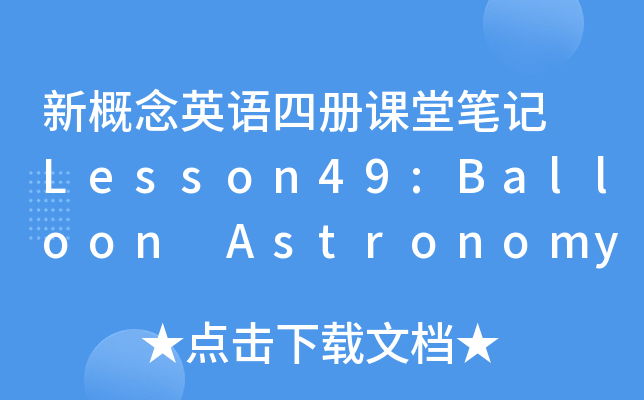–¬łŇńӔʒZ(y®≥)ňńÉ‘(c®®)’nŐ√ĻP”õ Lesson49:Balloon Astronomy
ēr(sh®™)ťg£ļ2016-03-31 10:38:00 ĀŪ(l®Ęi)‘ī£ļüo(w®≤)ĎnŅľĺW(w®£ng) [◊÷ůw£ļ–° ÷– īů]Hot-air balloons date back to the year 1783, and within a few months of the first flight a French scientist, Charles, went up two miles in a free balloon. Yet there is little resemblance between these crude vehicles and a modern scientific balloon, which has by now become an important research tool.
The main development has been carried out by M. Schwarlschild and his team at Princeton University in the United States, in collaboration with the United States Navy, the National Science Foundation, and the National Aeronautics and Space Administration. The 'Stratoscope' flights of 1959, concerned mainly with studies of the Sun, were remarkably successful, and the project has now been extended. With Stratoscope II, the overall height from the telescope to the top of the launch balloon is 666 feet, the balloons together weigh over two tons, and another two tons of ballast are carried for later release if height has be maintained during the night. The telescope, plus its controls weighs three and-a-half tons. Two large parachutes arc also carried; in case of emergency, the instruments and their records can be separated from the main balloon system, and brought down gently. Many of the radio and electronic devices used are similar to those of artificial satellites.
- –¬łŇńӔʒZ(y®≥)Ķŕ“ĽÉ‘(c®®)Lesson22“Ľ30’n…ķ‘~ļÕ∂Ő’Z(y®≥)
- –¬łŇńӔʒZ(y®≥)Ķŕ“ĽÉ‘(c®®)Lesson8“Ľ13’n…ķ‘~ļÕ∂Ő’Z(y®≥)
- –¬łŇńӔʒZ(y®≥)Ķŕ“ĽÉ‘(c®®)Lesson1-7’n…ķ‘~ļÕ∂Ő’Z(y®≥)
- –¬łŇńӔʒZ(y®≥)Ķ໿ɑ(c®®)ĪōĪ≥‘~ÖR44“Ľ46
- –¬łŇńӔʒZ(y®≥)Ķ໿ɑ(c®®)ĪōĪ≥‘~ÖR40“Ľ43
- –¬łŇńӔʒZ(y®≥)Ķ໿ɑ(c®®)ĪōĪ≥‘~ÖR34“Ľ39
- ≤ťŅī–¬łŇńӔʒZ(y®≥)»ę≤Ņőńôn >>


